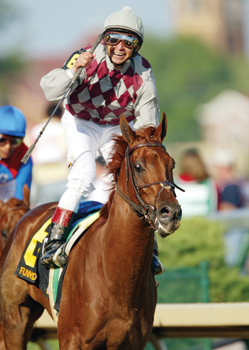A planned initial public offering that aimed to raise $24 million for ownership shares in portfolios of racehorses was put out to pasture this past summer.
The investment vehicle, headed by racing industry veteran Frank Stronach, was to launch six public companies, each of which would back 20 horses. As the filings with the Securities and Exchange Commission explain, the new ventures would have offered “a broad range of investors the opportunity to participate in the enjoyment and excitement of an equity investment in thoroughbred racehorses at a minimum level of investment [$100] commitment that is significantly lower than ordinarily accompanies such opportunity.” However, the IPO was scratched due to the complexity of the SEC rules and the state regulations governing the offering of shares and horse racing in general.
Instead, the venture will go forward as a series of private partnerships, which is common in the world of horse racing. For example, the winner of the 2011 Kentucky Derby, Animal Kingdom, is owned by a partnership of 20 people. The 2003 standout gelding Funny Cide is owned by a group of high school friends who pooled their money to start a breeding operation.
There are many different vehicles for getting off and running in the world of horse racing, but owning an individual horse is considered one of the most risk-laden. Horses are typically purchased a few years before they are set to race. During this time, a horse can become lame, frenzied, diseased or simply fail to turn into a winner. Horses can produce ancillary income after retirement by entering the breeding market, but most are simply a losing investment.
 |
2003 Kentucky Derby champ Funny Cide is owned by a group of friends who pooled their money to start a breeding operation.
Photo by: GETTY IMAGES
|
In a survey of the four most-expensive horses sold at auction, three of them have resulted in massive write-offs — each in the tens of millions of dollars. As the SEC filings from Stronach’s IPO acknowledge: “[I]nvesting in thoroughbred racehorses is a speculative activity and the most frequent financial outcome from ownership of a thoroughbred racehorse or an equity interest in a thoroughbred racehorse is the partial or total loss of invested capital.” Even among sophisticated investors with decades of experience in horse racing, such investments are essentially about the excitement and the pride of owning a champion, as opposed to the potentially massive but risky financial upsides. Given the volatility of racehorse fortunes, many investors have seen the wisdom of investing in a stable of horses. Much like investing in a slate of films or a mutual fund, the hope is that the winnings of some breakout animals will offset the losses incurred by the others.
The regulation of horse racing and other forms of gambling has traditionally been left to the states. This approach and the multitude of differing state laws makes any IPO for shares in a horse racing endeavor infinitely more complicated. As Stronach’s prospectuses highlighted, “[m]any of these regulations are subject to differing interpretations that may, in certain cases, result in unintended consequences that could materially and adversely impact the effective operation of our business.”
Regulatory uncertainty aside, the value of available race winnings, or purses, has remained stable over the past decade. The purses available for winning horses in the U.S. and Canada all together total more than $1.2 billion. While the cost of maintaining a champion thoroughbred can be substantial, an animal that finishes in the money at all three events in the Triple Crown can be valued at up to $50 million. With so much money at stake, there are many industry experts who make a living picking and grooming winning horses. Relying on such an expert buyer can help increase the chances of investing in a winning horse and mitigate some of the risks. Ownership is found at all income levels, with the largest group making less than $50,000 per year.
The allure, or mania, of investing in racehorses has attracted governments as well as starry-eyed investors. For example, the Irish parliament spent $700,000 in 1953, or the equivalent of $5.6 million today, on a racehorse from the Agha Khan in an effort to jump-start the Irish horse breeding industry. The move, decried by critics as lunacy at the time, has paid off in the long run. Ireland is now the third largest producer of foals behind the U.S. and Australia, and the industry is worth around $1.5 billion to Ireland annually. Similarly, the economic impact of horse racing in the U.S. is not to be ignored. According to a study commissioned by The Jockey Club, the sport contributes billions annually to the U.S. economy and provides jobs to nearly 1 million people.
For the bold, investing in racehorses has all the excitement, romance and drama of investing in a film, fine wine or any other exotic commodity. Even for those with financial acumen, the steep learning curve and substantial role that luck plays in the sport will give any investor a run for the money. With horse racing, it is surely the love of the sport that keeps investors climbing back into the saddle.
Robert Darwell (darwell@sheppardmullin.com) is the chair of Sheppard Mullin’s Entertainment, Media and Technology Practice Group and splits his time among Los Angeles, New York, Nashville and Buenos Aires. Sean Faussett (sean.faussett@gmail.com) is a third-year student at Loyola Law School and served as an intern at Sheppard Mullin.





